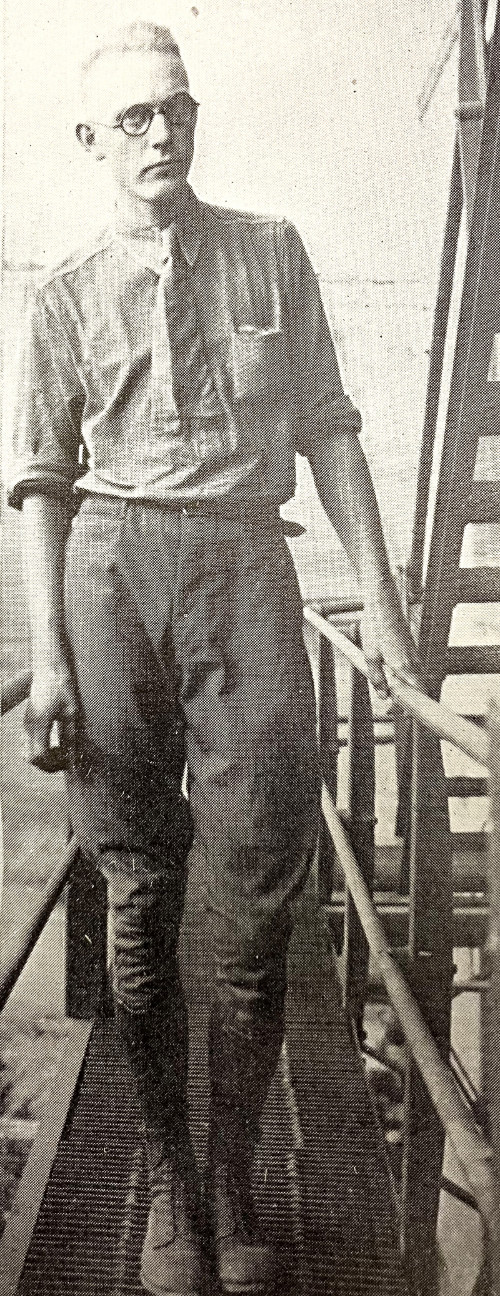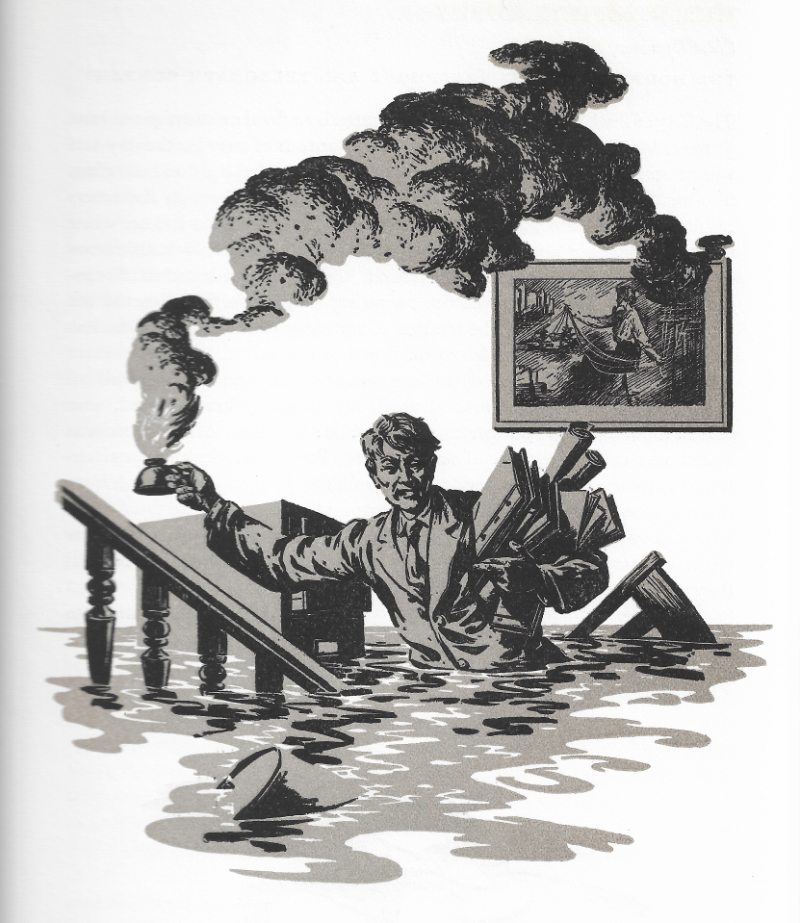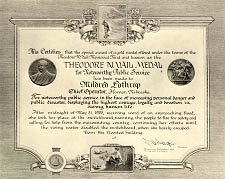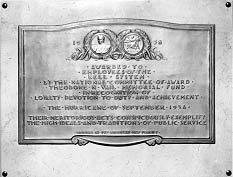
Byron Ernest Thady
Telecom Heroes
Byron Ernest Thady
On the night of June 3, 1921, 20-year-old Byron Thady was on duty in the central office in Pueblo, Colorado, when the city siren gave warning of an approaching flood (see more about the Pueblo Flood in the Disasters section). When the water began to come into the first floor of the telephone building, he was at the test board attempting to reach Denver. Within a few minutes water covered the board and it went out of service. At the same time all the electric lights, with the exception of three or four ground lamps on the generator frame, went out.
Byron went to the engine room and found an oilcan in which he soaked some rags as wicking. With the aid of a makeshift lamp, he saved the subscriber’s cable records and considerable office equipment by carrying them up to the second floor. By the time of his last trip the water was up to his waist. He was very nearly penned in one of the rooms when a heavy fire door jammed shut from the pressure of the water against it, but he was able to get out and reach the second floor.
Shortly all the electric lights in the operating room went out. He returned downstairs and brought back the temporary lights he had made with the oil and rags. By their light he strung a jumper wire from the batteries on the second floor to the operating room on the third floor to rig temporary emergency lights. These lights went out soon after, and from then until the following morning, the only illumination in the operating room was the light reflected from burning buildings around different parts of the city.

From For Noteworthy Public Service
According to Mrs. Prior, “Mr. Thady came staggering up the steps—his clothes were soaked and his hair was disheveled—a sort of calm fear was up on his face. ‘Mrs. Prior, you might as well take the girls on up to the third floor, I guess,’ he whispered to me, ‘it will be more comfortable for them up there, I think.’ ...
“We heard a man nearby crying for help. He was near our east windows. Mr. Thady opened the door to the fire escape. Across the alley, on top of a one-story garage, we saw him. He had in some way cut a hole through the roof and crawled up out of the water.” Though he risked being swept away by the floodwaters himself, Thady tried desperately (but unsuccessfully) to reach the man and his companion.
At about six o’clock the next morning the flood had receded sufficiently for the rescuers to take the girls out of the building in rowboats, but Thady remained on duty until two o’clock the next afternoon. When interviewed about his actions of that night, Byron Thady said modestly, “I simply did my duty. Why all this ado?”
For his cool thinking, bravery, and service to the company and his fellow employees, Byron Thady was awarded a Gold Vail Medal


Definition
The Vail Medal
The Vail Medal was created in 1920 in memory of Theodore N. Vail (President of the American Telephone and Telegraph Company from 1907 to 1919) to perpetuate his ideals of service to the public. The medal, which bears his likeness, was awarded to individuals for noteworthy acts reflecting the Bell System's highest traditions of loyalty and devotion to duty.
Adolph Alexander Weinman, one of the leading sculptors in the United States, designed the Vail Medal in 1921. In designing the medal, Mr. Weinman captured not only the personality of Vail, but also his ideals of service to the public.
The face of the medal bears a portrait of Vail, while on the reverse, the central figure represents the "Civilizing Force of Communication" speeding the winged message along the wires. At the right, "Loyalty to Service" upholds the left hand of the central figure, while a third figure, "Devotion to Duty," helps to support the lines of communication.
 There are three types of Vail Medals: bronze, silver, and gold. Bronze medals were awarded to individuals in each Bell System company by that company's awards committee. A Bell System Committee then reviewed these cases and selected those of "especially outstanding excellence or importance" for silver or gold medal awards.
There are three types of Vail Medals: bronze, silver, and gold. Bronze medals were awarded to individuals in each Bell System company by that company's awards committee. A Bell System Committee then reviewed these cases and selected those of "especially outstanding excellence or importance" for silver or gold medal awards.
A bronze medal was also awarded to groups of employees where the noteworthy act was due to the concerted action of the group, rather than by an individual.
An embossed citation certificate, with a brief description of the circumstances that occasioned the award, was given to each Vail Medal recipient. (The one pictured is Millie Lothrop's.) A bronze plaque commemorating the act was presented to the company concerned. These plaques were designed for display in telephone buildings as a permanent and public memorial. Plaques may be seen to this day in telephone company buildings across the nation.
 Up to the breakup of the Bell System in 1984, hundreds of awards were made to telephone company employees who embodied the ideal of service (see Heroes for some representative stories). Men and women of the Bell System performed acts of public service and bravery ranging from struggling through a blizzard to fix a downed line; saving a child from a burning building or a man from a raging flood; to staying at the switchboard while bullets flew—and were celebrated with the award of a Vail medal.
Up to the breakup of the Bell System in 1984, hundreds of awards were made to telephone company employees who embodied the ideal of service (see Heroes for some representative stories). Men and women of the Bell System performed acts of public service and bravery ranging from struggling through a blizzard to fix a downed line; saving a child from a burning building or a man from a raging flood; to staying at the switchboard while bullets flew—and were celebrated with the award of a Vail medal.
From For Noteworthy Public Service: Theodore N. Vail Medals National Awards, 1950, and The Mountain States Monitor, July 1921.
Additional Resources:
See more facts about Byron Ernest Thady and the events surrounding this story at the following links:Telecom Heroes
Byron Ernest Thady

Byron Ernest Thady
On the night of June 3, 1921, 20-year-old Byron Thady was on duty in the central office in Pueblo, Colorado, when the city siren gave warning of an approaching flood (see more about the Pueblo Flood in the Disasters section). When the water began to come into the first floor of the telephone building, he was at the test board attempting to reach Denver. Within a few minutes water covered the board and it went out of service. At the same time all the electric lights, with the exception of three or four ground lamps on the generator frame, went out.
Byron went to the engine room and found an oilcan in which he soaked some rags as wicking. With the aid of a makeshift lamp, he saved the subscriber’s cable records and considerable office equipment by carrying them up to the second floor. By the time of his last trip the water was up to his waist. He was very nearly penned in one of the rooms when a heavy fire door jammed shut from the pressure of the water against it, but he was able to get out and reach the second floor.
Shortly all the electric lights in the operating room went out. He returned downstairs and brought back the temporary lights he had made with the oil and rags. By their light he strung a jumper wire from the batteries on the second floor to the operating room on the third floor to rig temporary emergency lights. These lights went out soon after, and from then until the following morning, the only illumination in the operating room was the light reflected from burning buildings around different parts of the city.

From For Noteworthy Public Service
The water reached its height about two o’clock in the morning and maintained that level for about an hour before it began to recede. Throughout the night, Thady assisted the chief operator, Mrs. Joseph E. Prior, in keeping up the morale of the operators, telling them that the telephone building was strongly constructed and would be the last to give way in the whole neighborhood.
According to Mrs. Prior, “Mr. Thady came staggering up the steps—his clothes were soaked and his hair was disheveled—a sort of calm fear was up on his face. ‘Mrs. Prior, you might as well take the girls on up to the third floor, I guess,’ he whispered to me, ‘it will be more comfortable for them up there, I think.’ ...
“We heard a man nearby crying for help. He was near our east windows. Mr. Thady opened the door to the fire escape. Across the alley, on top of a one-story garage, we saw him. He had in some way cut a hole through the roof and crawled up out of the water.” Though he risked being swept away by the floodwaters himself, Thady tried desperately (but unsuccessfully) to reach the man and his companion.
At about six o’clock the next morning the flood had receded sufficiently for the rescuers to take the girls out of the building in rowboats, but Thady remained on duty until two o’clock the next afternoon. When interviewed about his actions of that night, Byron Thady said modestly, “I simply did my duty. Why all this ado?”
For his cool thinking, bravery, and service to the company and his fellow employees, Byron Thady was awarded a Gold Vail Medal


Definition
The Vail Medal
The Vail Medal was created in 1920 in memory of Theodore N. Vail (President of the American Telephone and Telegraph Company from 1907 to 1919) to perpetuate his ideals of service to the public. The medal, which bears his likeness, was awarded to individuals for noteworthy acts reflecting the Bell System's highest traditions of loyalty and devotion to duty.
Adolph Alexander Weinman, one of the leading sculptors in the United States, designed the Vail Medal in 1921. In designing the medal, Mr. Weinman captured not only the personality of Vail, but also his ideals of service to the public.
The face of the medal bears a portrait of Vail, while on the reverse, the central figure represents the "Civilizing Force of Communication" speeding the winged message along the wires. At the right, "Loyalty to Service" upholds the left hand of the central figure, while a third figure, "Devotion to Duty," helps to support the lines of communication.
 There are three types of Vail Medals: bronze, silver, and gold. Bronze medals were awarded to individuals in each Bell System company by that company's awards committee. A Bell System Committee then reviewed these cases and selected those of "especially outstanding excellence or importance" for silver or gold medal awards.
There are three types of Vail Medals: bronze, silver, and gold. Bronze medals were awarded to individuals in each Bell System company by that company's awards committee. A Bell System Committee then reviewed these cases and selected those of "especially outstanding excellence or importance" for silver or gold medal awards.
A bronze medal was also awarded to groups of employees where the noteworthy act was due to the concerted action of the group, rather than by an individual.
An embossed citation certificate, with a brief description of the circumstances that occasioned the award, was given to each Vail Medal recipient. (The one pictured is Millie Lothrop's.) A bronze plaque commemorating the act was presented to the company concerned. These plaques were designed for display in telephone buildings as a permanent and public memorial. Plaques may be seen to this day in telephone company buildings across the nation.
 Up to the breakup of the Bell System in 1984, hundreds of awards were made to telephone company employees who embodied the ideal of service (see Heroes for some representative stories). Men and women of the Bell System performed acts of public service and bravery ranging from struggling through a blizzard to fix a downed line; saving a child from a burning building or a man from a raging flood; to staying at the switchboard while bullets flew—and were celebrated with the award of a Vail medal.
Up to the breakup of the Bell System in 1984, hundreds of awards were made to telephone company employees who embodied the ideal of service (see Heroes for some representative stories). Men and women of the Bell System performed acts of public service and bravery ranging from struggling through a blizzard to fix a downed line; saving a child from a burning building or a man from a raging flood; to staying at the switchboard while bullets flew—and were celebrated with the award of a Vail medal.
From For Noteworthy Public Service: Theodore N. Vail Medals National Awards, 1950, and The Mountain States Monitor, July 1921.
Additional Resources:
See more facts about Byron Ernest Thady and the events surrounding this story at the following links:back to top
back to Andrew V. Smith
on to Robert K. Timothy